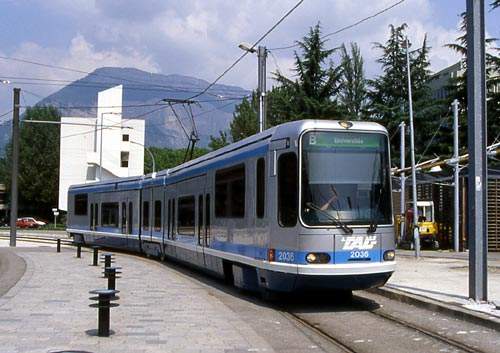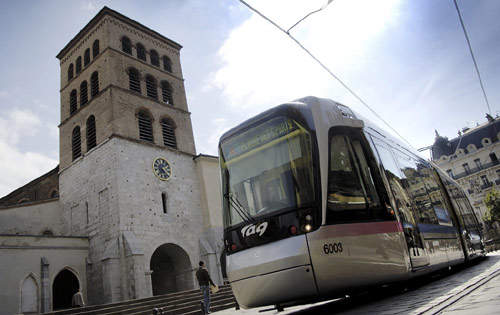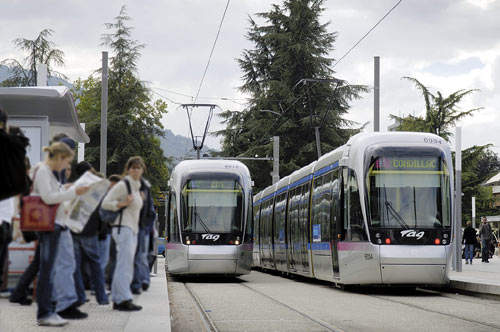Grenoble, the capital city of the Isère département in the Rhône-Alpes region in France, had a tram service until 1952. Like many French systems, it went out of existence due to the high cost for required renewals when compared to bus replacements, being perceived as an outmoded form of transport. When asked in 1983 whether they would like a modern tramway, voters were only narrowly in its favour.
Grenoble opened its first tramway in 1987 with an 8.8km (5.5 mile) line between Fontaine La Poya and Grand Place. With the opening of Line D in October 2007, the system had grown to four lines with a combined length of 34.2km (21.4 miles).
The Grenoble network is widely seen as an excellent example of marrying modern technology with sympathetic urban renewal.
It has won particular praise for providing far greater access and independent travel for those with impaired mobility through pioneering use of level access to low floor vehicles.
Grenoble’s pioneering tramway system
Along with Nantes, Grenoble was in the first wave of modern French tramways. The network was intended to play an integral part in redevelopment of the whole city, which also included ridding large parts of the central area of most road vehicles, creating pedestrian-only zones, building renovations and landscaping.
Contrary to opposition in some quarters claiming that banning the private car would damage retail business, shops and leisure facilities in the central area experienced resurgence, circumstances that have helped ease the adoption of new tramways in many other cities.
The branding for public transport in the metropolitan area is TAG (from Transports de l’Agglomération Grenobloise). Like several French tramways, the Grenoble system is operated by Transdev, which is also a partner in the area’s mixed sector SEMITAG authority. Despite being situated in a famously mountainous area, Grenoble itself is relatively flat. A regional centre for Rhône-Alpes and with a large student population, the city attracts many visitors.
Infrastructure of the French city’s tramway
Track gauge is 1,435mm and the overhead power supply is rated at 750V DC. Completion of the initial section of Route A was followed by Line B, on which work began in October 1990.
Sharing the first section of the network between the main SNCF railway station and city centre with Route A, it branches east and runs 5.8km (3.5 miles) to serve a major hospital complex and the university campus, which engendered the name ‘le tramway des etudiants’ (the students’ tramway).
Lines linking such types of civic institution have become a characteristic of modern French systems, with these major population concentrations generating sufficient traffic to fill the trams to capacity at peak periods.
Further extensions were added to Line A – a total of 3.8km – taking the route to Echirolles and Denis Papin between 1996 and 1998.
The contract was let in early 2001 for a 13.5km (8.4-mile) Line C linking Seyssins, Seysinnet, St Martin d’Hères and the SNCF’s station at Gieres, the site of a planned stop on the future Lyon-Turin high-speed rail line. The line was completed in March 2006, with 26 stations serving 60,000 residents and creating 30,000 jobs.
A short extension of Line B opened in March 2006. With a short section shared with Line C, Line D linking Les Taillées Universités to Saint-Martin-d’Hères opened in October 2007.
The network is characterised by a high level of park and ride places dispersed around the network, in order to encourage tram use around the central area.
Rolling stock used on the public transport network
Grenoble had at the outset the only entirely low-floor fleet in use in France, all units being part low-floor Tramway Français Standard (TFS) built by GEC Alsthom. Unlike the previous TFS-1 as operated in Nantes, Grenoble’s TFS-2 had all doorways giving access to a low-floor section.
There were 39 TFS vehicles with a 186 passenger capacity in the original batch and a further 14 were introduced between 1995 and 1997.
These featured a revised interior and are powered by GEC-Alsthom’s Onix traction package which is more compact and designed for reduced maintenance and power consumption.
In spite of the implication in its full name, the TFS proved to be short-lived and additions to the fleet have been from the highly successful Alstom Citadis modular range. Like the TFS-2, which remains the numerically dominant type in Grenoble, the Citadis variation is bi-directional.
At 43.7m, almost 15m longer than the TFS, the 100% low-floor Citadis type 402 specified for Grenoble has capacity for 274 passengers (82 seated). The vehicles, resulting from an order placed in 2003, entered service in 2006.
Signalling, communications, security and the future for Grenoble’s trams
Grenoble ordered video surveillance to increase safety and security for both passengers and operational staff. New York-based Verint Systems was chosen to supply networked video, which assists organisations in preventing incidents and allows improvements to be made to response times. Onboard and tram stop information systems are fitted.
As with other French tramway systems, trams in Grenoble receive priority at road junctions to assist in maintaining timetables. In addition to ticketing for all TAG, joint tickets are available that also cover SNCF’s TER regional trains or the Transisère bus network.
The growth of the Grenoble tramway and the resurgence of the city as a destination are indicative of the system’s success. In November 2007, TAG placed an order for a further 15 Citadis 402 trams. Eight additional train sets worth €27 million were ordered in 2011. These will be delivered in stages between 2013 and 2014.
In 2013 a Line B extension will open from Cité Internationale to Polygone Scientifique. Projects for extensions of several lines are due for completion up to 2013. A new line E would extend the system to Meylan in the northeast.
A long-term plan is to reduce reliance upon travel through the city centre lines with a southern extension of Line D to connect with Line C in the southwest. The muted tram-train service in the Grenoble area has yet to gain substance.







